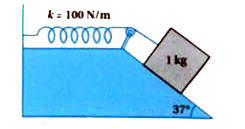Five sinusoidal waves have the same frequency 500 Hz but their amplitudes are in the ratio 2:12:12:1:1and their phase angles 0,π6,π3,π2andπ respectively. The phase angle of resultant wave obtained by the superposition of these five waves isSolution in Gujrati
30∘
45∘
60∘
90∘
The correct Answer is:B

Here we are asked to find out phase angle which is also called phase constant. It is the phase at t=0. Hence let us consider superposition of five given waves at time t=0.
Now,
y1=2Asin(ωt)=0(∵t=0)
y2=A2sin(ωt+30∘)=A2sin30∘=A4
y3=A2sin(ωt+60∘)=A2sin60∘=√3A4
y2=Asin(ωt+90∘)=Asin90∘=A
y5=Asin(ωt+180∘)=Asin180∘=0
Now, y=y1+y2+y3+y4+y5
=0A4+√3A4+A+0
=5A+√3A4=A4(5+√3)...(1)
Now, (at t=0)
x1=2Acos(ωt+0∘)=2Acos0∘=2A
x2=A2cos(ωt+30∘)=A2cos30∘=√3A4
x3=A2cos(ωt+60∘)=A2cos60∘=A4
x4=Acos(ωt+90∘)=Acos90∘=0
x5=Acos(ωt+180∘)=Acos180∘=−A
Now x=x1+x2+x3+x4+x5
=2A+√3A4+A4+0−A
∴x=A+√3A4+A4=A4(5+√3) ...(2)
Now, if phase angle of resultant wave at the point of superpositon of above five waves is ϕR then,
tanϕR=yx=1
(∵ Here y = x from equations (1) and (2))
∴ϕR=45∘
Topper's Solved these Questions
- BOOK - KUMAR PRAKASHANCHAPTER - WAVESEXERCISE - SECTION-F (Questions From Module) (Sample questions for preparation of competitive exams)23videos
WAVES
- BOOK - KUMAR PRAKASHANCHAPTER - WAVESEXERCISE - SECTION-D (NCERT Exemplar Solution) (Long Answer Type Questions)5videos
WAVES
- BOOK - KUMAR PRAKASHANCHAPTER - UNITS AND MEASUREMENTEXERCISE - Section -F (Questions from Module )20videos
UNITS AND MEASUREMENT
- BOOK - KUMAR PRAKASHANCHAPTER - WORK, ENERGY AND POWER EXERCISE - QUESTION PAPER (SECTION - D)1videos
WORK, ENERGY AND POWER
Similar Questions
In a standing wave formed by two atoms separated by 1.21Å, there are 3 nodes and 2 antinodes. Find its wavelength.
View SolutionThe earth has a radius of 6400 km. The inner core of 1000 km radius is solid. Outside it, there is a region from 1000 km to a radius of 3500 km which is in molten state. Then again from 3500 km to 6400 km the earth is solid. Only longitudinal (P) waves can travel inside a liquid. Assume that the P wave has a speed of 8 kms−1 in solid parts and of 5kms−1 in liquid parts of the earth. An earthquake occurs at some place close to the surface of the earth. Calculate the time after which it will be recorded in a seismometer at a diametrically opposite point on the earth if wave travels along diameter ?
08:31View SolutionIf the error in measurement of radius of a shpere is 2% then the error in determination of volume of the sphere will be …………
03:11View SolutionA 1 kg block situated on a rough incline is connected to a spring constant 100Nm−1 as shown in figure . The block is released from rest with the spring in the unstretched position . The block moves 10 cm down the incline before coming to rest . Find the coefficient of friction between the block and the incline .Assume that the spring has a negligible mass and the pulley is frictionless.
 03:10View Solution
03:10View SolutionThree component sinusoidal waves progressing in the same directions along the same path have the same period byt their amplitudes are A,A2andA3. The phases of the variation at any position x on their path at time t=0are0,−π2and−π respectively. Find the amplitude and phase of the resultant wave.
02:23View SolutionFive sinusoidal waves have the same frequency 500 Hz but their amplitudes are in the ratio 2 : 1//2 : 1//2 :1:1 and their phase angles 0 , pi//6 , pi//3 , pi//2 and pi , respectively . The phase angle of resultant wave obtained by the superposition of these five waves is
04:24View SolutionThree simple harmonic waves , identical in frequency n and amplitude A moving in the same direction are superimposed in air in such a way , that the first , second and the third wave have the phase angles ϕ,ϕ+(π/2)and(ϕ+π), respectively at a given point P in the superposition
Then as the waves progress , the superposition will result in02:13View SolutionThe resultant amplitude, when two waves of two waves of same frequency but with amplitudes a_(1) and a_(2) superimpose at phase difference of pi//2 will be :-
09:43View SolutionA sinusoidal wave travelling in the same direction have amplitudes of 3 cm and 4 cm and difference in phase by π/2. The resultant amplitude of the superimposed wave is
08:47View Solutiona1 तथा a2 आयामों तथा समान आवृति की दो तरंगो के अध्यारोपण से उत्पन्न परिणामी तरंग का आयाम बताइए। जबकि तरंगो का कलान्तर (i)π/2(ii)π तथा (iii)2π है।
07:28View SolutionTwo waves of same amplitude a and frequency v and having a phase difference of pi//2 radian, are superposed. The amplitude of resultant wave is
06:35View SolutionThree sinusoidal waves having same frequency have amplitudes in the ratio 6:3:2 and their phases are 0, pi/2 ,pi . If 6a be the amplitude of the first wave , then which of the following is not correct
06:35View SolutionFive sinusoidal waves have the same frequency 500 Hz but their amplitudes are in the ratio 2 : 1//2 : 1//2 :1:1 and their phase angles 0 , pi//6 , pi//3 , pi//2 and pi , respectively . The phase angle of resultant wave obtained by the superposition of these five waves is
04:31View SolutionThree component sinusoidal waves progressing in the same direction along the same path have the same period but their amplitudes are A, A/2 and A/3. The phases of the variation at any position x on their path at time t = 0 are 0, −π2and−π respectively. Find the amplitude and phase of the resultant wave.
05:19View SolutionFive frequency waves have the same frequency as 500 Hz but their amplitude 2:(1)/(2):(1)/(2):1:1 And the angle of their waves respectively 0,(pi)/(6),(pi)/(3),(pi)/(2) And pi is. The art angle of the resulting wave obtained by the imposition of these five waves is-
03:37View Solution
